20dfs ransomware is the virus that locks files on the system to have a reason for money demands
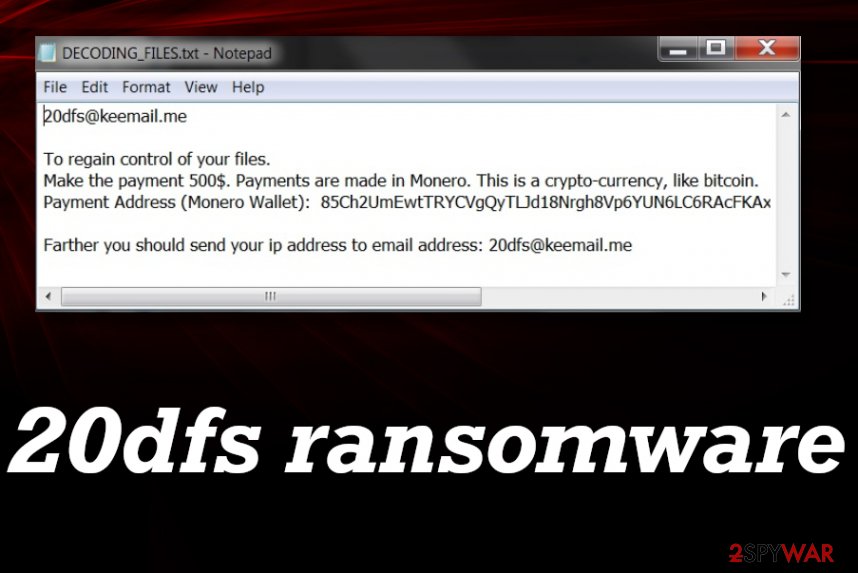

20dfs ransomware – the cryptovirus that demands a payment of $500 for the alleged file unlocking. Files get encrypted as soon as this threat lands on the system because money is the main focus of these cybercriminals. The main process of the encoding ends with file locking and marking. During the latter, .20dfs file appendix gets added at the end of every file name. So once your files get encrypted the name consists of all the original information and the appendix at the end. You can’t open any of these affected files because army-grade encryption algorithms make files useless until decryption tools change them back to normal. Unfortunately, this virus is not decryptable right now, so there are fewer options for you, but paying the ransom shouldn’t be one of them. Criminals only care about their own gains, so your files and belongings are not the first priority.
20dfs ransomware virus is the cryptocurrency-extortion based threat, so blackmail should immediately indicate that there is no reason to trust these malicious actors. You should ignore the ransom note that comes in DECODING_FILES.txt file, rely on AV tools, and remove the virus instead of considering the payment transfer or other options. This virus removal method is not recovering your encoded files, but you need to fully clean the system before you can load data backups and replace affected files with safe copies.
| Name | 20dfs ransomware |
|---|---|
| Type | Cryptovirus[1] |
| File appendix | .20dfs is the marker that gets at the end of every encrypted file |
| Ransom note | DECODING_FILES.txt contains the ransom demanding message and contact information, a particular amount of money demanded form victims |
| Amount of ransom | $500 in Monero[2] cryptocurrency |
| Distribution | The ransomware is spreading around with the help of malicious files, links that trigger downloads of payload or MS documents that get attached to spam emails |
| Elimination | 20dfs ransomware removal procedure requires professional anti-malware programs that can detect and delete those malicious programs and terminate this virus fully for you |
| Repair | Rely on the PC repair tool or the optimizer application that could find and repair files on system folders. Try Reimage Reimage Cleaner Intego for this purpose |
20dfs ransomware spreads the infection quickly and affects the performance of the computer significantly because it manages to change settings, add or disable functions, install or delete programs, files in system folders. The threat is focused on data alterations, so various file recovery functions get disabled on purpose.
When the threat changes some of the settings, deletes files, you cannot easily remove 20dfs ransomware from the computer. It is not possible due to alterations or full lockdown of the machine. You may need to enter the Safe Mode first, so you can run the anti-malware tool then and find all programs that pose the danger on your system. Repair those affected system files with Reimage Reimage Cleaner Intego when you are done terminating the threat.
The process of 20dfs ransomware removal gets difficult, so you should rely on tips below and follow the guide for better results. Also, rely on anti-malware tools that can be trusted. Running an AV engine can determine how affected your computer is. You may need to try a few tools when you find the one that can detect the particular ransomware. It is common because different databases are used by different AV engines. This is not a widely spread threat, and there are not many samples of it.
No matter how many tools you need to try, do so. It is extremely important to fully delete all files associated with 20dfs ransomware before you repair the damage and replace files with safe copies from your backups. This is the best option for encrypted files because you truly can know that those files from the cloud archive or the external backup are safe and can be used later on. 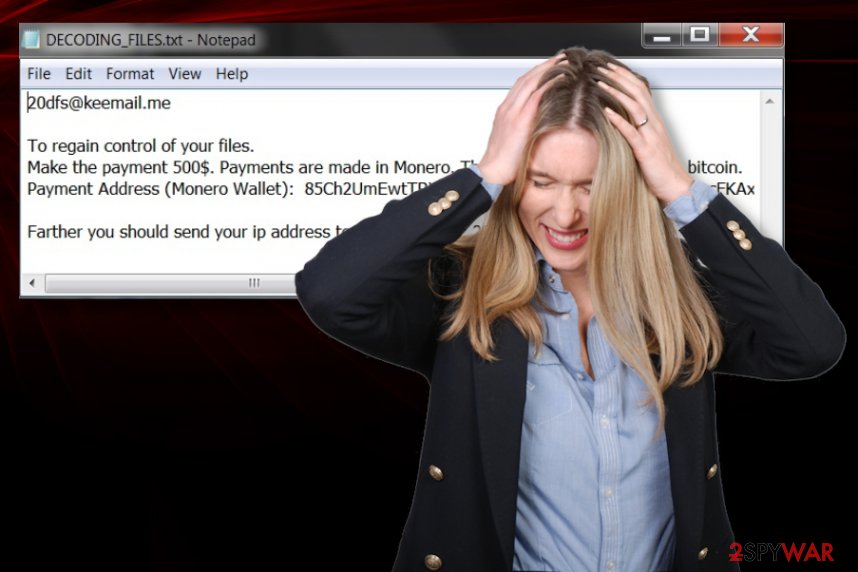
20dfs ransomware – the threat that runs the malicious script and encodes your files.

20dfs ransomware – the threat that runs the malicious script and encodes your files.
.20dfs virus can alter files in software folders, functions of the machine, and even add other programs to ensure that needed processes are launched and other functions get disabled. BUT. These background processes only are secondary. The main issue is encryption. After which you receive the following message:
To regain control of your files.
Make the payment 500$. Payments are made in Monero. This is a crypto-currency, like bitcoin.
Payment Address (Monero Wallet): 85Ch2UmEwtTRYCVgQyTLJd18Nrgh8Vp6YUN6LC6RAcFKAxSDASgxv69jA62hDRnLio2U2zNwXrPJpXScBRGaX6QZSJViRrWFarther you should send your ip address to email address: [email protected]
This message should be ignored because paying the attackers is not the best option that could help to deal with 20dfs ransomware infection. Anti-malware tools can remove the virus, but remember that this process is not going to repair your encoded files. It is not happening automatically too though. You need data recovery options, choose something below.
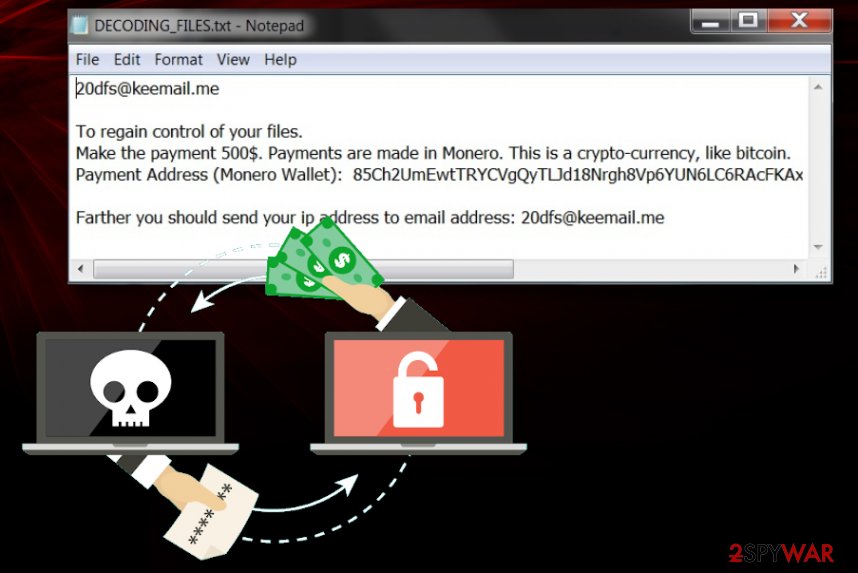
20dfs ransomware – cryptovirus that is focused on blackmailing messages and gaining money from victims.

20dfs ransomware – cryptovirus that is focused on blackmailing messages and gaining money from victims.
Rely on trustworthy sources and pay attention to red flags to avoid cyber infections
Malicious files[3] are the main vectors that ransomware developers use for the distribution because users can skip through checking the email notification sender, scanning the file for malware traces. When the macro virus-filled document gets opened, you get the infection automatically launched on the computer.
Once the malicious code gets injected on the machine, your files get automatically altered and encrypted, so you experience all the issues at once. You cannot avoid this because files get triggered automatically the second you open the link or a document on the machine. If you pay attention to suspicious senders, social media accounts, and shady links on such notification, email messages, you can avoid the infiltration fully.
Get rid of the 20dfs ransomware virus properly
You can remove 20dfs ransomware easily if you choose proper anti-malware tool and run the full system scan on the computer. This is required because malware can renew its processes when some files are left behind in the system. Run a proper security tool like SpyHunter 5Combo Cleaner or Malwarebytes and clear the threat off of your device.
After such a 20dfs ransomware removal procedure, you need to double-check for traces. Do not forget to do so because once you add recovered files on the computer threat can trigger second round of encryption. Also, to make your life easier, run Reimage Reimage Cleaner Intego and repair system files that get corrupted during the malicious processes. This is the helper before you try to recover files because some of the functions get repaired, and you have more solutions.
Remove 20dfs using Safe Mode with Networking
Reboot the machine in a Safe Mode with Networking and then remove 20dfs ransomware fully using the AV tool
- Windows 7 / Vista / XP
- Click Start → Shutdown → Restart → OK.
- When your computer becomes active, start pressing F8 multiple times until you see the Advanced Boot Options window.
- Select Safe Mode with Networking from the list
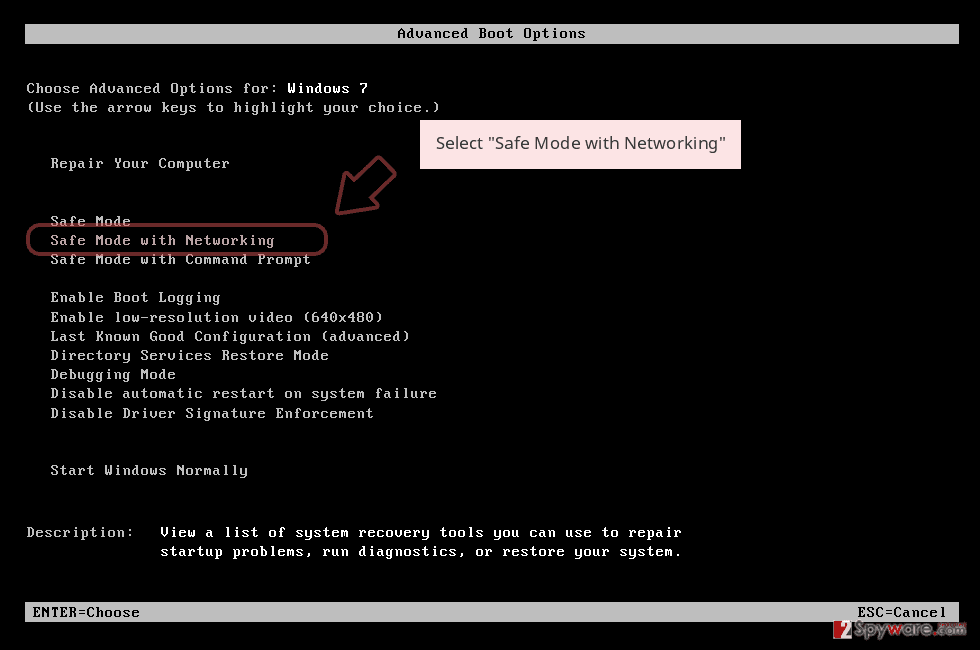
Windows 10 / Windows 8
- Press the Power button at the Windows login screen. Now press and hold Shift, which is on your keyboard, and click Restart..
- Now select Troubleshoot → Advanced options → Startup Settings and finally press Restart.
- Once your computer becomes active, select Enable Safe Mode with Networking in Startup Settings window.
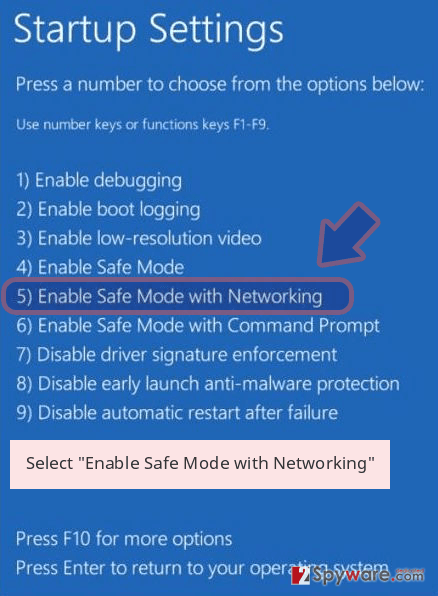
-
Log in to your infected account and start the browser. Download Reimage Reimage Cleaner Intego or other legitimate anti-spyware program. Update it before a full system scan and remove malicious files that belong to your ransomware and complete 20dfs removal.
If your ransomware is blocking Safe Mode with Networking, try further method.
Remove 20dfs using System Restore
System Restore feature can help you with the ransomware termination
Bonus: Recover your data
Guide which is presented above is supposed to help you remove 20dfs from your computer. To recover your encrypted files, we recommend using a detailed guide prepared by 2-spyware.com security experts.
If your files are encrypted by 20dfs, you can use several methods to restore them:
Data Recovery Pro can restore your data when the virus encrypts important files
When you accidentally delete files or ransomware-type threat encodes them, you need to restore documents, photos, other files that are important to you
- Download Data Recovery Pro;
- Follow the steps of Data Recovery Setup and install the program on your computer;
- Launch it and scan your computer for files encrypted by 20dfs ransomware;
- Restore them.
Windows Previous Versions feature for the file recovery
If you enabled System Restore before, you can rely on Windows Previous Versions feature
- Find an encrypted file you need to restore and right-click on it;
- Select “Properties” and go to “Previous versions” tab;
- Here, check each of available copies of the file in “Folder versions”. You should select the version you want to recover and click “Restore”.
Rely on ShadowExplorer and restore files after encryption
When Shadow Volume Copies are not affected, you can use this method and restore files encoded by 20dfs ransomware virus
- Download Shadow Explorer (http://shadowexplorer.com/);
- Follow a Shadow Explorer Setup Wizard and install this application on your computer;
- Launch the program and go through the drop down menu on the top left corner to select the disk of your encrypted data. Check what folders are there;
- Right-click on the folder you want to restore and select “Export”. You can also select where you want it to be stored.
20dfs ransomware is not decryptable
Finally, you should always think about the protection of crypto-ransomwares. In order to protect your computer from 20dfs and other ransomwares, use a reputable anti-spyware, such as Reimage Reimage Cleaner Intego, SpyHunter 5Combo Cleaner or Malwarebytes
The government has many issues in regards to tracking users’ data and spying on citizens, so you should take this into consideration and learn more about shady information gathering practices. Avoid any unwanted government tracking or spying by going totally anonymous on the internet.
You can choose a different location when you go online and access any material you want without particular content restrictions. You can easily enjoy internet connection without any risks of being hacked by using Private Internet Access VPN.
Control the information that can be accessed by government any other unwanted party and surf online without being spied on. Even if you are not involved in illegal activities or trust your selection of services, platforms, be suspicious for your own security and take precautionary measures by using the VPN service.
Computer users can suffer various losses due to cyber infections or their own faulty doings. Software issues created by malware or direct data loss due to encryption can lead to problems with your device or permanent damage. When you have proper up-to-date backups, you can easily recover after such an incident and get back to work.
It is crucial to create updates to your backups after any changes on the device, so you can get back to the point you were working on when malware changes anything or issues with the device causes data or performance corruption. Rely on such behavior and make file backup your daily or weekly habit.
When you have the previous version of every important document or project you can avoid frustration and breakdowns. It comes in handy when malware occurs out of nowhere. Use Data Recovery Pro for the system restoring purpose.
This entry was posted on 2020-06-23 at 05:35 and is filed under Ransomware, Viruses.

